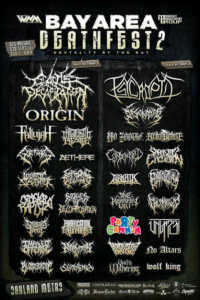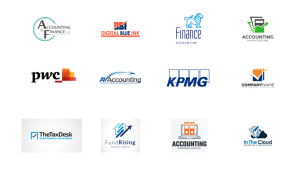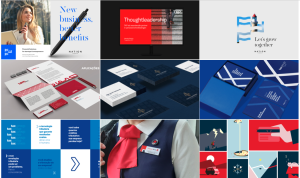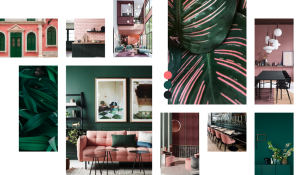If you’re in marketing and branding, you want your brand to stand out and capture your target’s attention. But so often, brands will look, sound and act like the rest of their competition. In order to stand out, you’ve got to break from your category’s convention and look, sound and act utterly distinctive so that you become memorable from the rest. How do you do that?
First – What is category convention?
Here’s a great example. If you’re a heavy metal fan and were in San Francisco in 2015 you probably would’ve seen this poster plastered all over town:

The Von Restorff Effect and Category Convention
And if you’re like 99.8% of the people out there, your eyes would have automatically gravitated to one particular band.
No slight to the other talented bands on this poster, but this is an excellent example of Category Convention. To understand its power, we need to first understand the Von Restorff Effect, also known as ‘the isolation effect,’ which was codified in 1934 by German psychologist Hedwig von Restorff (1906–1962), who found that when participants were presented with a list of categorically similar items with one distinctive, isolated item on the list, they recalled the one distinctive item the most.
For example, if a person sees a shopping list with one item highlighted in bright green, s/he will be more likely to remember the highlighted item than any of the others. Or, given a list of words – desk, chair, bed, table, chipmunk, dresser, stool, couch – “chipmunk” will be remembered the most, as it stands out against the other words in its meaning.
In other words: if you want to be memorable you’ve got to stand out.
But let’s get back to heavy metal and Category Convention. As I mentioned, if you’re like most people out there, you would’ve noticed one particular band: Party Cannon. That’s because its logo is bright and colorful and a direct contrast to the spidery gothic script that the other heavy metal bands used. In fact, I’d be willing to assume that you noticed no other band except for Party Cannon. Wouldn’t you want that kind of impact for your business?
That’s why it’s super important to make sure your business stands out in every possible way, to capture people’s attention and stay in their memory.
So how do you do that?
Discover Your Category’s Convention
The first thing you need to do is discover your category convention. You’ll want to spend some time looking at your category critically. Who are all the players? What language do your competitors use? What about dominant colors? How do they talk about themselves – what tone do they use? Are they light and personable, or formal? Let’s bring this to light with an example.
One of our clients is in the tax & accounting sector. When we looked at the category convention for the accounting sector, here’s what we found:

Tax and accounting logo category convention
We saw a lot of spreadsheets, boxes, checkmarks and arrows in their logos.
In terms of names, the vast majority of them had surnames as their business names, like “Thompson & Greenspon” or “The Goldin Group.” PWC and KPMG all stand for the original partners’ surnames.

Category convention colors
In terms of colors, we saw a lot of blue, reds and oranges. Arrows, boxes, check marks. Good to know.
We made a note of all the category convention cues and listed them as everything we wanted to avoid.
When it came time to design the brand, we knew exactly how to create differentiation. We recommended a name that created a warm association (our client stayed with her original name, Monarch CPA, which we loved because it was distinctive), and recommended dark green and coral colors (to cue financial prosperity and vitality, while also avoiding the category convention) and a logo – an elephant, emblematic of a monarch, one that is intelligent and majestic. Visually these cues were wildly different from the competition.

Breaking the accounting category convention

warm, differentiated, approachable
Category Convention in Communications
We also looked at language. For most of the competition, they spoke in 3rd person and had a formality to their communications. We opted to go more direct and casual, speaking to her audience in the 2nd person, and in an approachable, friendly manner. We avoided the dreadfully dry and verbose accounting speak. In doing so, we helped her business stand out from the competition and signal a very different look and feel. She was thrilled with her rebrand experience and the differentiation we created for her. You can explore the website more fully here.
Go Beyond Your Category Convention
DIYers: when turning to your own business, you’ll want to do this exercise thoroughly. Begin by exploring how your competition communicates visually and verbally. Make a note of tone of voice, brand personality and archetypes, color and even font selection. Dig deep and look at all facets of communications: from company name to logo, colors, font, copy, images, everything. Then draft up your notes. Work with a talented design team who can help you pivot off your category convention into a white space that feels distinctively different and right for your brand.
Need help? Give us a shout. We regularly help our clients stand out from the competition with great success. We work to uncover the category convention for all our clients, a standard part of our process and we’d love to help your business stand out and make you magnetic to success, too.
